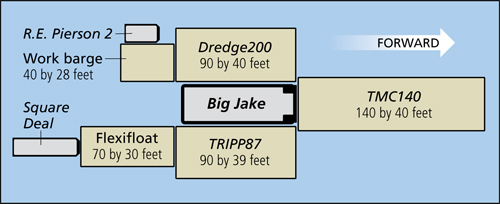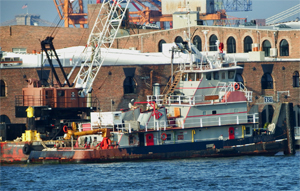Big Jake guided an eight-vessel flotilla of dredging equipment north in Massachusetts Bay as wind and wave conditions got steadily worse. Ninety minutes after sunrise on a dreary December morning, the port-side face wires connecting the tugboat and lead barge snapped.
Big Jake lost its steering and communications capability and more vessels broke free as the tow came broadside to the seas near Scituate, Mass. A dredge barge and workboat worth a combined $1.98 million sank. Two crewmembers were injured.
Wave forecasts for the flotilla’s 43-mile leg from the Cape Cod Canal to Hingham Bay, near Boston, exceeded the 4-foot limit the captain and tugboat owner set before departure. The decision to press on in unfavorable conditions was a primary cause of the incident, according to National Transportation Safety Board (NTSB) investigators.
“The pre-planning phase carried out by the captain, owner and customer proved to be ineffective,” the NTSB report said. “In particular, there were no safe harbors or alternate routes identified in case heavy weather should be forecasted during the voyage.”
Additionally, Coast Guard investigators identified more than two dozen deficiencies related to navigation, maintenance, survival and life safety, and electrical systems aboard the 46-year-old tugboat after the incident. Safer Tug & Barge of Egg Harbor, N.J., owned Big Jake at the time. The company could not be reached for comment.
Safer Tug & Barge held a contract to transport five dredge barges and two workboats from Riverside, Conn., to Hingham Shipyard Marinas in Hingham, Mass., located roughly 15 miles south of Boston.
The makeup for the tow was as follows: The 86-foot Big Jake faced up to TMC140, a 140-foot split-hopper dump scow; the workboat R.E. Pierson 2, an unnamed 40-foot work barge and the 90-foot dredge barge Dredge200 were tied up along the tug’s port side; and the 90-foot barge TRIPP87, an unnamed 70-foot Flexifloat modular barge and the workboat Square Deal were tied along the starboard side.
The 6,000-hp Big Jake drove the entire eight-vessel flotilla for part of the journey, while R.E. Pierson 2 and Square Deal each pushed two smaller barges independently at times. The vessels left Riverside, Conn., on Nov. 30 after finding a suitable weather window for the estimated 40- to 45-hour voyage. The crew consisted of a captain, Big Jake’s owner serving multiple roles, an engineer, mate, deck hand and crane operator.
 |
|
An NTSB diagram shows how the flotilla was arrayed before it broke apart. |
|
Pat Rossi illustration |
The vessels reached Buzzards Bay, near the west end of the Cape Cod Canal, at 1230 on Dec. 1. According to the NTSB report, the flotilla received permission to pass through the canal at 2248 on Dec. 1. The transit required one-way traffic and a fair tide given the unusual nature of the tow, investigators said.
As Big Jake waited to transit the canal, its captain and owner heard weather forecasts calling for stronger winds and rougher seas starting early on Dec. 2 in Cape Cod Bay and Massachusetts Bay. Crew aboard the tug requested permission to transit the canal earlier, but marine traffic controllers did not approve the requests. The flotilla got underway Dec. 1 at 2252 and left the canal less than two hours later.
Conditions in Cape Cod Bay and Massachusetts Bay worsened over the next five hours, with seas rising to 6 feet. The crew set to work after sunrise securing and adding lines to bolster the tow. As the tug’s owner assisted, a winch crank handle under tension on R.E. Pierson 2 released, striking him in the face. The wound bled profusely, impeding his sight. Another crewman fell to the deck of Big Jake later that morning while descending a forward ladder, injuring his back and shoulder.
The port face wire connecting Big Jake to barge TMC140 snapped at 0832 on Dec. 2. The tug’s steering system failed moments later, pushing the rudders to hard-over. At about the same time, most of the tug’s navigation electronics stopped working, the NTSB reported. Crew later determined that a steering hose had ruptured, spraying hydraulic fluid on the 12-volt batteries that powered the navigation equipment. Crew also learned that Big Jake’s VHF radio antenna was damaged.
With the tow broadside to the seas, Dredge200 rocked repeatedly against Big Jake’s port side, likely damaging starboard shell plating on the barge. Meanwhile, TMC140 came to rest against TRIPP87 on Big Jake’s starboard hip.
“As the crew attached lines to TMC140, lines started to part on TRIPP87 and the (modular) barge,” the NTSB report stated, noting that by then Dredge200 was taking on water and its bow was low.
“Over the course of about 30 minutes, the crew attempted to keep the barges and workboats together, to no avail,” the NTSB said. “When the crew deemed it was unsafe to continue their efforts, the barges and workboats drifted away from Big Jake with the exception of TRIPP87, which remained tethered to Big Jake’s starboard side by a 5-inch towing hawser.”
Big Jake’s captain notified the Coast Guard of the worsening situation at about 0930. The Coast Guard cutter Key Largo responded, along with the tugboats Smith Predator, Justice and Kendall J. Hebert, which recovered three barges and Square Deal. R.E. Pierson 2 and Dredge200 could not be saved.
Dredge200 came to rest about 15 miles to the north in 100 feet of water, just outside the main shipping channel into Boston Harbor. Investigators could not identify why it sank. R.E. Pierson 2 was never found.

